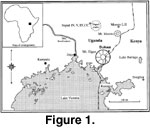INTRODUCTION
 The Bukwa site is located 4.0 km east of the village of Bukwa,
Kapchorwa District, eastern Uganda (34ƒ47’East longitude, 1ƒ17’North latitude)
on the northeastern side of the extinct early Miocene alkaline volcano Mt. Elgon
(Figure 1).Ý Bukwa was first discovered in 1965 (Walker 1969).Ý Excavations at Bukwa
during the 1960s yielded an extensive mammalian fauna and paleobotanical
remains, as well as invertebrates, fish, reptiles, and birds, that are dated at
about 22 Ma (Walker 1969; redating of the site is in progress).Ý The main
faunal site is Bukwa II, which produced the lagomorph and rodents described
here. Fossils from Bukwa II were recovered primarily from a green clay that
likely represents lacustrine deposition (Walker 1969). The only rodents reported previously from Bukwa
were Megapedetes pentadactylus (spring hare; Walker 1969), Bathyergoides
neotertiarius (mole rat;
Pickford 2002), and thryonomyoids (relatives of
the modern cane rat), including Paraphiomys pigotti, P. stromeri,
and some smaller unassigned taxa (Lavocat 1973).
The Bukwa site is located 4.0 km east of the village of Bukwa,
Kapchorwa District, eastern Uganda (34ƒ47’East longitude, 1ƒ17’North latitude)
on the northeastern side of the extinct early Miocene alkaline volcano Mt. Elgon
(Figure 1).Ý Bukwa was first discovered in 1965 (Walker 1969).Ý Excavations at Bukwa
during the 1960s yielded an extensive mammalian fauna and paleobotanical
remains, as well as invertebrates, fish, reptiles, and birds, that are dated at
about 22 Ma (Walker 1969; redating of the site is in progress).Ý The main
faunal site is Bukwa II, which produced the lagomorph and rodents described
here. Fossils from Bukwa II were recovered primarily from a green clay that
likely represents lacustrine deposition (Walker 1969). The only rodents reported previously from Bukwa
were Megapedetes pentadactylus (spring hare; Walker 1969), Bathyergoides
neotertiarius (mole rat;
Pickford 2002), and thryonomyoids (relatives of
the modern cane rat), including Paraphiomys pigotti, P. stromeri,
and some smaller unassigned taxa (Lavocat 1973).
Lavocat (1973, p. 158) briefly mentioned 12 teeth or
fragments of teeth collected by Walker and associates from Bukwa in 1968.Ý Lavocat
assigned most of these specimens to either the thryonomyids Paraphiomys pigotti
or P. stromeri.Ý Four teeth were considered similar to P. stromeri,
but of smaller size and sometimes of slightly different morphology.
The specimens described here were collected in 2002 from
Bukwa II by L. MacLatchy, W. Downs, R. Kityo (Makerere University, Uganda), and
E. Musiime (Uganda Museum).Ý At Bukwa II, Will Downs collected two burlap bags
of the green clay (Bukwa IIA) and two bags that included green clay plus
overlying brown marl (Bukwa IIB).Ý Will believed the bone was coming from the
junction of the two units.Ý In map view, Bukwa IIA and B are about 5 m apart.Ý
This sediment was dried in the field then washed through tandem screen boxes at
Makerere University; the fine fraction was washed repeatedly in the United
States.Ý The coarse fraction was sorted in Uganda.Ý Will Downs sorted the
fine fraction under a dissecting microscope at the Museum of Northern Arizona
University.Ý In addition to rodents, Bukwa IIA also yielded an upper cheek
tooth of Myohyrax oswaldi (Macroscelididae), a frog humerus, and
fish teeth and vertebrae; Bukwa IIB produced rodents, a lagomorph, and fish
vertebrae.
The Bukwa rodents and lagomorph described here are housed at
the Uganda Museum, Kampala, under the acronym BUMP (Boston University/Uganda
Museum/Makerere University Paleontology Expeditions).Ý Other abbreviations:
AMNH, American Museum of Natural History, New York; N, number of specimens; SO
or KNM SO, Songhor locality, Kenya.

 The Bukwa site is located 4.0 km east of the village of Bukwa,
Kapchorwa District, eastern Uganda (34ƒ47’East longitude, 1ƒ17’North latitude)
on the northeastern side of the extinct early Miocene alkaline volcano Mt. Elgon
(Figure 1).Ý Bukwa was first discovered in 1965 (Walker 1969).Ý Excavations at Bukwa
during the 1960s yielded an extensive mammalian fauna and paleobotanical
remains, as well as invertebrates, fish, reptiles, and birds, that are dated at
about 22 Ma (Walker 1969; redating of the site is in progress).Ý The main
faunal site is Bukwa II, which produced the lagomorph and rodents described
here. Fossils from Bukwa II were recovered primarily from a green clay that
likely represents lacustrine deposition (Walker 1969). The only rodents reported previously from Bukwa
were Megapedetes pentadactylus (spring hare; Walker 1969), Bathyergoides
neotertiarius (mole rat;
Pickford 2002), and thryonomyoids (relatives of
the modern cane rat), including Paraphiomys pigotti, P. stromeri,
and some smaller unassigned taxa (Lavocat 1973).
The Bukwa site is located 4.0 km east of the village of Bukwa,
Kapchorwa District, eastern Uganda (34ƒ47’East longitude, 1ƒ17’North latitude)
on the northeastern side of the extinct early Miocene alkaline volcano Mt. Elgon
(Figure 1).Ý Bukwa was first discovered in 1965 (Walker 1969).Ý Excavations at Bukwa
during the 1960s yielded an extensive mammalian fauna and paleobotanical
remains, as well as invertebrates, fish, reptiles, and birds, that are dated at
about 22 Ma (Walker 1969; redating of the site is in progress).Ý The main
faunal site is Bukwa II, which produced the lagomorph and rodents described
here. Fossils from Bukwa II were recovered primarily from a green clay that
likely represents lacustrine deposition (Walker 1969). The only rodents reported previously from Bukwa
were Megapedetes pentadactylus (spring hare; Walker 1969), Bathyergoides
neotertiarius (mole rat;
Pickford 2002), and thryonomyoids (relatives of
the modern cane rat), including Paraphiomys pigotti, P. stromeri,
and some smaller unassigned taxa (Lavocat 1973).